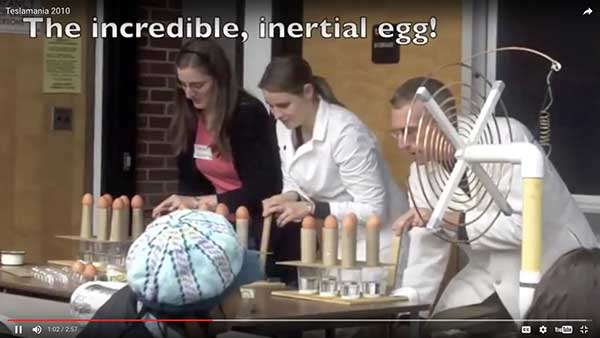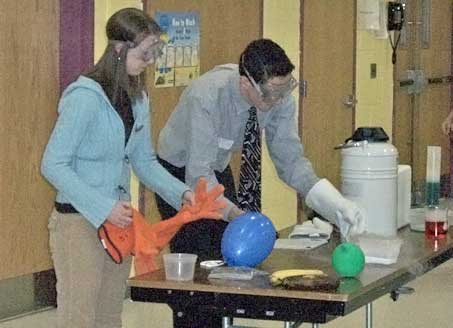Stony Brook University Physics Teacher Preparation Program – The 6 ‘C’ s.
Keith Sheppard, Robert McCarthy, Angela Kelly, and Axel Drees, Stony Brook University
Physics Teacher preparation is thriving on Long Island. Stony Brook University (SBU) has been awarded a PhysTEC 5+ award for the last three years and is on course to graduate at least six physics teachers with majors in physics in 2016-17. SBU is unusual in that it does not have a Department of Education, and teacher preparation for all of the sciences is distributed across the various scientific departments in collaboration with the Institute for STEM Education (I-STEM). The university has enjoyed a strong partnership among the Physics department, the Institute for STEM Education (I-STEM), and regional K-12 schools for many years, and that has been integral in its success in producing physics teachers.
The SBU Physics Teacher preparation program has a long rich history, with Clifford Swartz, a faculty member of the Physics Department and for 30 years an editor of “The Physics Teacher,” being integral in its establishment and development. Cliff was legendary for his innovative lectures and dedication to physics teacher education, and he helped to train several generations of Long Island physics teachers. Since 1994, when record keeping began, the university has produced 85 certified physics teachers (60 majors and 25 minors).
The Physics Teacher preparation programs at SBU are characterized by what we describe as the “6 C Model.” Most importantly the programs are Content Rich. Prospective physics teachers can follow one of three pathways to New York (NY) state certification — an undergraduate route, a graduate MAT route, and a combined BS/MAT route. The undergraduate route requires completion of a BS degree in Physics. The graduate and combined routes require the completion of a BS degree in physics plus 15 graduate credits in physics. With New York State requiring teachers to complete a master’s degree for the award of a professional license, the vast majority of our Physics teachers complete the graduate or combined pathway options. All of the physics courses are taught through the Physics department.
In addition, our programs are Clinically Rich. All program graduates have been exposed to extensive school-based experiences before student teaching. Methods courses are taught by highly experienced former teachers. There are two tenured faculty members who hold physics certification and have extensive experience teaching high school physics: one teaches undergraduate physics courses, and the other directs the science teacher education programs. This clinical richness is enhanced by the demographic factors of the Long Island region. The region (Nassau and Suffolk counties) is a ‘hotbed’ for physics teaching, with over 250 NY certified physics teachers teaching in the region’s 108 high schools; this includes more than 110 teachers who teach AP Physics. For the majority of physics teachers in the region, physics teaching is their only assignment, and the vast majority of the schools have more than one physics teacher. In addition to Nassau and Suffolk county schools, the Queens and Brooklyn boroughs of New York are on Long Island and employ an additional 150 physics teachers.
This environment leads to the programs being Context Rich, with extensive professional physics teacher support in the region. The Long Island Physics Teacher Association (LIPTA) is large and very active. The New York State Master Teacher Program (NYSMTP) for Long Island also has a large and active Physics Teacher section that is involved in numerous professional development activities for teachers. The region holds its own annual, well-attended physics teacher demonstration competition, Teslamania, which is organized and run by physics teachers from Long Island. The rich environment provides a cadre of highly qualified, experienced physics teachers who are able to act as cooperating teachers for student teachers in physics.
The need for physics teachers in the region is considerable, which has given rise to a relatively stable population of physics teachers. The SBU physics teacher program has an 86% five-year retention rate, i.e., 86% of the physics teacher graduates are teaching high school physics five years after graduating. We describe this as being Continuity Rich, and many of our graduates are now our program’s cooperating teachers. A factor contributing to physics teacher retention are the salaries offered in the area. Starting salaries for Physics teachers with an MAT degree are approximately $60,000, and the majority of physics teachers in Nassau County earn in excess of $100,000, though it should be noted that the region has a very high cost of living.
In common with many programs that produce multiple physics teachers, the SBU physics teacher program is Champion Rich — with, as previously described, strong advocates in multiple areas — the Physics Department, I-STEM, and the region’s K-12 school community. These champions have allowed us to actively recruit undergraduate students (SBU has a relatively large UG physics population), and funding from the NSF Noyce Program and Petrie Foundation has allowed us to financially support students as they complete the teacher preparation program. And the final C is Capacity Rich. SBU has the capacity to double or even triple its production of physics teachers.
We would like to acknowledge the NSF Noyce Program and Carroll and Milton Petrie Foundation, for their financial support of Physics pre-service students. Their funding has allowed Stony Brook to move from producing 3-4 physics teachers per year to 5-6 teachers per year.
Keith Sheppard directs the science teacher preparation programs and has taught high school physics in England, Tanzania and the USA, before moving into higher education.
Robert McCarthy is a professor of Physics, the Undergraduate Physics program director and the Physics Education program advisor.
Angela Kelly taught high school physics in New Jersey and now teaches undergraduate physics courses.
Axel Drees is the Chair of the Physics Department and an ardent supporter of Physics Teacher Preparation Programs.

Teslamania: Long Island Physics Teacher Demonstration Competition (http://teslamaniacompetition.org/)

Students at school-based field experiences
Disclaimer – The articles and opinion pieces found in this issue of the APS Forum on Education Newsletter are not peer refereed and represent solely the views of the authors and not necessarily the views of the APS.
